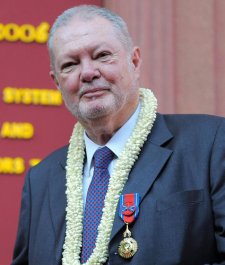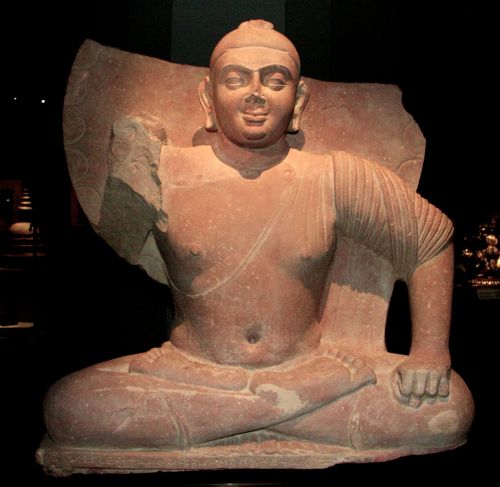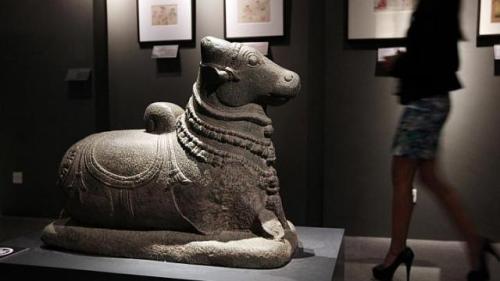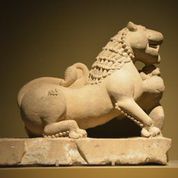In 2005, Canada’s Royal Ontario Museum was offered a rare sculpture of a Seated Buddha carved from red sandstone in the second century. It was from India’s ancient city of Mathura, the second capital of the Kushan empire, and one of only a handful of such sculptures to have appeared on the market in recent years.
 The dealer selling the sculpture was Nancy Wiener, whose eponymous Manhattan gallery has been a leading seller of Asian art for years. Her clients include the Metropolitan Museum, the Los Angeles County Museum, the Asia Society and prominent private collectors. Wiener’s mother Doris was a renowned Asian art dealer who Christies’ called “one of the most distinguished tastemakers in this collecting category.”
The dealer selling the sculpture was Nancy Wiener, whose eponymous Manhattan gallery has been a leading seller of Asian art for years. Her clients include the Metropolitan Museum, the Los Angeles County Museum, the Asia Society and prominent private collectors. Wiener’s mother Doris was a renowned Asian art dealer who Christies’ called “one of the most distinguished tastemakers in this collecting category.”
The Royal Ontario was keen to buy the Seated Buddha – until curator Deepali Dewan called the expert who had authenticated the sculpture for Wiener. Donald Stadtner, an authority in Indian art, told Dewan that he believed the statue had been illegally exported from India and given a phony ownership history to cover its tracks.
 After talking to Stadtner, the Royal Ontario Museum decided pass on the sculpture, Dewan confirmed in a recent email. Months later, Wiener offered it to the National Gallery of Australia for USD$1.2 million.
After talking to Stadtner, the Royal Ontario Museum decided pass on the sculpture, Dewan confirmed in a recent email. Months later, Wiener offered it to the National Gallery of Australia for USD$1.2 million.
No Questions Asked at the National Gallery of Australia
Wiener told NGA officials she had purchased the sculpture in 2000, museum records show. Previously, Wiener said, the sculpture had belonged to an Englishman named Ian Donaldson, who claimed to have purchased it while posted in Hong Kong between 1964 and 1966. She provided the museum with a 1985 Certificate of Ownership signed by Donaldson. It was the only record of sculpture’s ownership history, but the museum did not attempt to contact Donaldson.

In July 2007, Wiener sent an invoice to the NGA for the discounted price of USD$1,080,000 and a signed guarantee offering to reimburse the museum if the provenance were ever proven false.

Two months later, as preparations for the Buddha’s acquisition were under way, the National Gallery of Australia received a search certificate from the Art Loss Register saying the sculpture was not in its database of stolen objects. Such declarations are largely useless for looted antiquities – as the certificate notes, “the database does not contain information on illegally exported artifacts unless they have been reported to us as stolen.”
Yet this was the extent of the museum’s due diligence. Museum officials never contacted Stadtner, whose authentication report for the Seated Buddha was among the paperwork provided by Wiener. The funds for the purchase were provided in part by Ros Packer, wife of the late media tycoon Kerry Packer and one of Australia’s most prominent philanthropists.
An Anonymous Tip
In 2012, I got an anonymous tip that the sculpture’s ownership history had been fabricated. The source identified the dealer as Nancy Wiener, and suggested the sculptures had been illegally exported from India. I shared the tip with Michaela Boland at The Australian, and in May 2013 we requested the sculpture’s ownership history from the NGA. The museum claimed the information was secret: “We do not provide details of this nature regarding acquisitions from the national art collection for clear commercial in confidence reasons,” museum spokesman David Edhill wrote.
Boland filed a Freedom of Information request for the records. In the fall of 2014, the Australian courts ruled in our favor and released copies of the NGA’s records – with the name of the dealer and former owner redacted. In November, we co-wrote a story in Australian about the case, linking the anonymous tip to the account in the museum records.
The Latchford Connection
In October 2014, as the records were released, the NGA began investigating the ownership history of the sculpture. It was only then that an NGA curator contacted Stadtner and asked him for any information he had about the sculpture’s origins.
In a Nov. 5th email to museum officials, Stadtner explained his long-held suspicions about the sculpture. The NGA’s was the second Kushan Buddha that Stadtner had examined for Wiener, he explained. The first he had studied in 1999 before it was sold to Singapore’s Asian Civilizations Museum.
Some time after, on a visit to Bangkok, Stadtner said he met with the Bangkok-based British collector Douglas Latchford. The main topic of conversation was Latchford’s role in the sale of fake Burmese bronzes, Stadtner said, one of which had been sold to the ACM in Singapore in 2000. While there, however, the two men discussed the ACM’s Seated Buddha.
“During the course of a long conversation (and boasting) Latchford said, en passant, that he found Nancy a provenance for the Buddha which by then was in Singapore,” Stadtner told NGA officials in the email. “I recall that he said that he found ‘an old India hand’ in ‘Hong Kong’. By an old India hand I interpreted this to mean an older English gentlemen who had served in India but who was based then in Hong Kong.”
 Stadtner was convinced the NGA’s Seated Buddha, sold several years later, had been offered with the same false story. “I strongly suspect that the ‘old India hand’ in H.K. will appear in the paperwork for both Buddhas, if my memory was correct and indeed he found this fellow in H.K. to provide the bogus certificates to Nancy for at least the Singapore Buddha.”
Stadtner was convinced the NGA’s Seated Buddha, sold several years later, had been offered with the same false story. “I strongly suspect that the ‘old India hand’ in H.K. will appear in the paperwork for both Buddhas, if my memory was correct and indeed he found this fellow in H.K. to provide the bogus certificates to Nancy for at least the Singapore Buddha.”
The NGA’s records, which Stadtner had not seen, appear to support his story: Wiener told the museum that the Buddha had belonged to a British ex-pat living in Hong Kong. Did Donaldson own the statues? What is his connection to Latchford? It is difficult to know: Andrew Ian Donaldson, listed at the same Hong Kong address supplied by Wiener, died in 2001, records show.
Latchford, whose alleged role in the Seated Buddha transactions has not been previously reported, did not respond to multiple requests for comment. His London attorney, however, was in touch. “Our client does not know Mr Stadtner, nor has he ever met him,” wrote Amber Melville-Brown of Withers LLP. “He is completely at a loss as to why Mr Stadtner would make such false assertions.”
Stadtner told me he has very specific memories of his visit to Latchford’s Bangkok apartment. I asked to interview Latchford to clarify the confusion. “My client is, as I have already pointed out, a frail, elderly gentleman in poor health,” wrote Melville-Brown. “Accordingly, it would be quite inappropriate for him to be interviewed by you about this matter and he is unable to do so.”
In 2012, Latchford was identified in federal court records as a middleman in the trafficking of looted antiquities from Southeast Asia. Authorities allege Latchford knowingly purchased two looted Khmer sculptures from “an organized looting network” and conspired with the London auction house Spink to obtain false export permits for them. The case was a civil lawsuit, and Latchford was not charged with a crime. But after a lengthy legal battle, Sotheby’s agreed to return its sculpture to Cambodia. Soon after, the Norton Simon Museum, Christie’s auction house and the Metropolitan Museum of Art all returned sculptures tied to Latchford. UPDATE: The Cleveland Museum returned another looted Khmer sculpture linked to Latchford in May 2015.
Melville-Brown,Latchford’s attorney, has previously asked me to remove our past coverage of Latchford’s role in the Sotheby’s case. I have declined, noting that the account is based on federal court records protected under U.S. law.
Stonewalling in Singapore
The Asian Civilizations Museum has refused to release the ownership history for its Seated Buddha. When pressed repeatedly, a spokesperson for the museum said, “The Kushana Buddha was purchased from a respected international dealer in the year 2000, who had purchased it from a private collector who had owned the piece since the 1960s.” Is that private collector Ian Donaldson? The museum won’t say.
Last fall, I went by Nancy Wiener’s Manhattan gallery to see if she could clarify the history of the Seated Buddha sculptures. Her gallery manager refused me entry and claimed he did not know how to put me in touch with Wiener. She has not responded to emails.
In January, the Times of India reported that Australian authorities had concluded that the NGA’s Seated Buddha was stolen from an archaeological site and agreed to return it to India. National Gallery spokeswoman Alison Wright would neither confirm nor refute that account, but acknowledged that the museum “commenced legal discussions” with Wiener in November. “Those discussions have not yet concluded and therefore we are not able to comment further,” she said.





 Last December we
Last December we 







 Selina Mohamed was charged with four counts of criminal possession of stolen property and one count of conspiracy, court records show. She is the third person criminally charged in the case, following the indictments of Kapoor’s sister
Selina Mohamed was charged with four counts of criminal possession of stolen property and one count of conspiracy, court records show. She is the third person criminally charged in the case, following the indictments of Kapoor’s sister 



 Finally, Mohamed allegedly provided false provenance for a torso of a Vedata that was reported as stolen from Karitalai, India in 2006 on the Interpol database. Kapoor put its value at $450,000, noting in his catalog, “This ornamentation is nearly identical to the jewelry seen on the famous sculpture of a
Finally, Mohamed allegedly provided false provenance for a torso of a Vedata that was reported as stolen from Karitalai, India in 2006 on the Interpol database. Kapoor put its value at $450,000, noting in his catalog, “This ornamentation is nearly identical to the jewelry seen on the famous sculpture of a 
